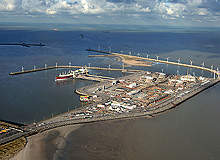
The Zeebrugge liquefied natural gas (LNG) terminal is situated on a 30ha site in the outer port of Zeebrugge, Belgium. The terminal was commissioned in 1987 and supplies loading and unloading facilities for LNG carriers. It is operated by Fluxys LNG, part of Belgian independent natural gas transport company Fluxys. The facility has an annual throughput capacity of nine billion cubic meters (bcm) of natural gas.
The terminal can handle all types of LNG carriers including Q-Flex carriers which have a capacity of about 217,000m³ of LNG. The LNG can be unloaded from ships and stored in tanks, regasified and transmitted for consumption by the Belgian market.
Facilities are also available at the terminal to load LNG onto LNG ships. These ships transport the LNG to other markets such as the UK, the Netherlands, Luxembourg, France and Southern Europe.
The terminal is currently being modified to handle Q-Max vessels. The modification works are expected to be completed by the end of 2011.
Terminal construction and infrastructure
The terminal features reception facilities, four LNG storage tanks, vaporisation and send-out facilities and related utilities.
Three of the storage tanks have a capacity of 80,000m³ of LNG and the fourth storage tank has a capacity of 140,000m³ of LNG.
The fourth storage tank was added between 2004 and 2008 as part of an expansion plan to increase the capacity of the terminal from 4.5bcm/y to the current 9bcm/y.
Vaporisation and send-out facilities help in pumping regasified gas into the high-pressure gas network. The firm send-out capacity of the terminal is 1,700,000m³/h. The terminal uses submerged combustion vaporisers (SCV) which reduce fuel gas consumption. The SCVs heat water which in turn vaporises the LNG contained in a stainless steel tube heat exchanger.
The terminal’s jetty includes four 16in LNG unloading arms. It also features a vapour return arm having an unloading capacity of up to 14,000m³/h of LNG. The terminal has been built in a sheltered location which protects LNG carriers from sea water currents during berthing and unloading.
Zeebrugge LNG terminal extension
In 2009, Fluxys announced its plans to build an open rack vaporiser (ORV) at the terminal. ORVs use heat from the seawater to heat LNG and help in decreasing fuel gas consumption. The project is expected to be completed by 2012.
Fluxys is also planning a capacity enhancement project for the terminal. The project will include the addition of a second jetty for berthing of LNG carriers with a capacity of 3,500m³ – 217,000m³ of LNG. The new jetty is expected to be completed by 2014.
The project also includes the construction of a LNG storage tank with a capacity of 160,000m³ of LNG. Construction of the storage tank is expected to be completed by 2016. Upon completion, the project will increase the terminal’s send-out capacity by 450,000m³/h and the annual throughput capacity by 2-3bcm/y.
Contractors
A consortium consisting of Saipem, CFE and FONTEC was awarded the engineering, procurement and construction contract for the 2004-2008 expansion project. Scope of work included construction of the LNG storage tank and regasification facilities.
Solétanche Bachy was awarded the contract for carrying out diaphragm wall works for the fourth LNG storage tank in 2005. The company also carried out similar works for the other storage tanks in 1982.
Tractebel Engineering carried out a feasibility study for the 2004-2008 expansion project. The company also carried out a technical feasibility study for installation of the ORV. In addition, Tractebel Engineering carried out a pre-feasibility study for the capacity enhancement project.
Portugal’s Sociedade de Montagens Metalomecânicas (SMM) was responsible for the mechanical erection of the fourth storage tank. SMM also laid all the necessary process piping.
Zeebrugge site
The Zeebrugge terminal is strategically situated to transport LNG between various markets in Europe. As gas imports made by Europe are increasing, the importance of the terminal is on the rise. As a result, activity levels at the terminal are continuously increasing. In 2009, 82 LNG vessels docked at the terminal, compared with 43 in 2008.



